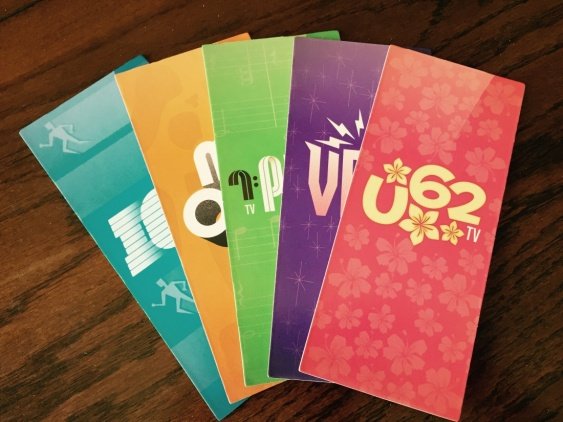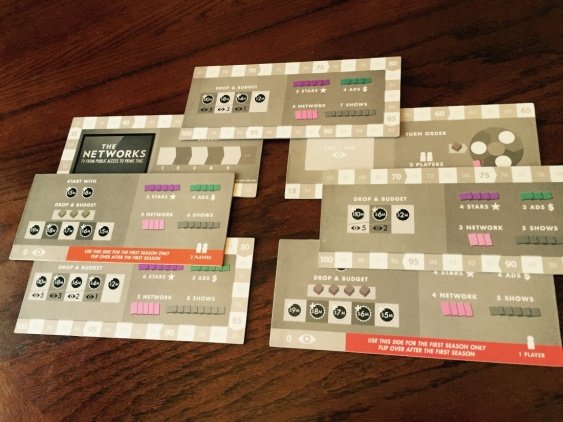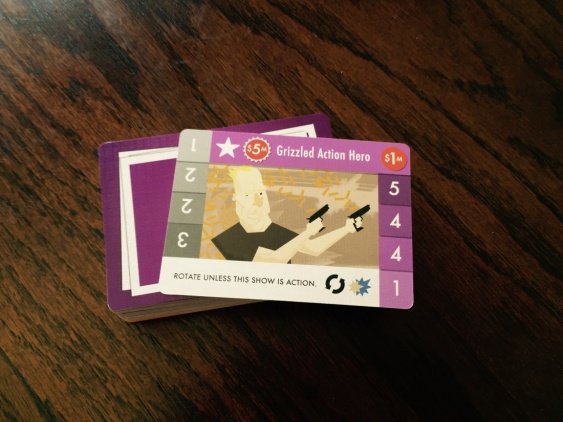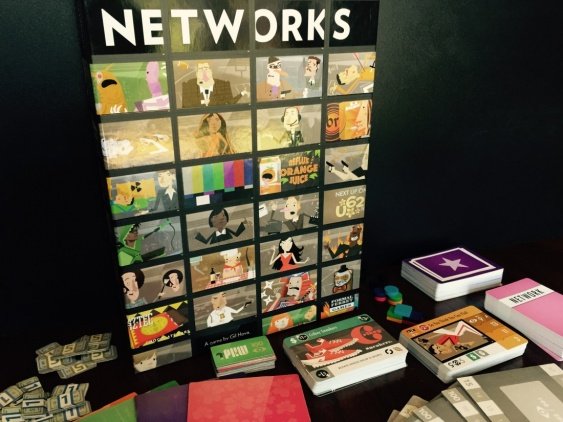Oh television, how we adore you. You now, what, never mind. Screw television—we all just watch Netflix anyway, right. I mean, television’s programming and everything wrapped up in competing for viewers and programming can be exhausting. Finally, someone made a board game poking fun at it. The only problem is that, in some ways, it’s as perplexing as the real thing.
Title: The Networks
Designer: Gil Hova
Publisher: Formal Ferret Games
Players: 1-5
Price: TBD August 2016
How Does it Play?
The Networks basically puts players in the role of a television producer. You own your own station and compete against other players to purchase shows, land ads, and hire actors. The game revolves around seasons, and the goal is to get more viewers than everyone else.
It’s a pretty cool idea that makes for a decent enough game. It does contain some problems, but most of those aren’t really in the concept and play of the game. Even after hearing about the game’s premise alone, creating a tv station and competing for viewers, I thought, “Yeah, that sounds like a game.”

Each player gets a random station, which comes with some specific starting shows, ads, and actors. It doesn’t really matter which station you get; all of the starting cards for each station are equally bad and you’ll only improve by buying the new ones. On your station card, you’ll see three-time slots—8pm, 9pm, and 10pm. This means that you can only have 3 shows on your lineup at any given time. When buying a new show, you need to pay attention to it’s recommended time slot, because you’ll get more viewers if you air the show at the right time.
The same basically goes for actors as well. They aren’t required to be on at a specific time for more viewers, but they do have preferences as to what types of shows they like to star in. For instance, if an actor is an aspiring dramatist, and you cast her in a comedy, she won’t perform as well and you’ll get fewer viewers. I really like this mechanic because it makes perfect sense.
You can also replace shows as you see fit during the season, so long as you have actors to cast in them. These shows get placed in the rerun pile, and will still garner some views when you count them all up at the end of the season. However, when a season ends, all shows get cancelled and you’ll start fresh. In this way, it’s all about the money, too, which you get from landing ads and placing them in time slots. At the end of the season, your ads will help replenish your cash to spend during the next season.
Seriously, can we play yet?
No matter how much fun you have with The Networks when playing, there is one glaring difficulty up front: learning it. The first time you play, jumping right in is going to be a pain. Before you do anything, you’re going to need to read the 19-page game manual and figure out the layout of the actual game board pieces (of which there are many).
When I first play these games for review, I like to gather some players around the table and jump right in, often before I’ve even opened the box and read the rules. This is useful, because while I sometimes have a chance to play these games beforehand at a convention, where the creators of the game are there and walking me through it, most people don’t have that luxury. They’ll be learning the game on their own, so it’s worth it to understand how accessible the game is to the average consumer. How easy is the game to hop into for a group of players who don’t already know the ins and outs?

I hadn’t played The Networks before my review, but man, I really wish I had. Honestly, the first time I sat down with some friends and cracked open the box, we never got around to playing. We were too busy combing through the manual for nearly an hour. Eventually, everyone lost interest and started doing something else.
Here’s the thing. Games can be as complex as they need to be, and there’s no bad thing about that. I’ve played tabletop games that took an extreme amount of time to read through the rules, set up the play space, and get through a whole game. That is fine, so long as the experience is worth it. When you get into a deep role-playing game, you want a big game, and you often need to understand many mechanics in order to get the intended experience. The difference between those games and The Networks is that they pay off in the end. You put a lot of effort into learning The Networks and it just doesn’t reciprocate in the same way other games might.
Can’t Please Them All
If I were to name the number one problem with The Networks, it’s that it seems like the game is trying too hard to please as many people as possible. In more than one way, it adds too much to the game to be as fun and accessible as it could be. One way I’ve already mentioned is that it is too complicated to be initially fun. At times, with all of the setup required and the weird way that you track player progress on the game board, it seems that it doesn’t understand how simple it should be. This is more of a board game, not a tabletop RPG, but sometimes it tries too hard to be the latter when it should embrace the simplicity of the former.
It’s not like you can’t have an in-depth and lengthy experience with a simple game. Monopoly is very simple in every way—moving on the board is simple, buying properties is simple, handling the money is simple—and it doesn’t require a 20-page book to learn. Kids can play Monopoly without even understanding exactly what to do. They roll the dice, move their pawn, collect their money, and spend their money. The Networks, with its art style, it’s theme, and it’s general play, should be more simplistic. It should strive to be more like a board game because that is what it is.
The other way that the game stretches itself out where it shouldn’t is the number of players. The game is playable with a group of 3-5 players, 2 players, or simply 1 player. I strongly recommend multiple players! Making the game playable with less is a cool idea, and some games can pull this off. Where The Networks goes wrong is by requiring you to manipulate an already messy game board and ruleset to accommodate the different number of players.
For instance, if you’re playing with 3-5 players, you just use everything in the box—all the cards, all the tokens, all the pieces of the game board. However, if you decide to play with 2 players, or even want to go solo, you’ll need to make adjustments to the game board, the cards, and the rules. These adjustments make an already convoluted game even more difficult to grasp. In my opinion, it should just stick with a set number of players and keep it there. Besides, it isn’t like playing with only 2 players is really that fun. And 1 player? Forget it.
Redeeming Qualities
There is some worth in The Networks, though. Like I said in the beginning, this is a great idea for a game. And really, once you do play a few times and have the rules down pat, you’ll probably be alright, it’s just that getting there is a pain.
Also, the cards are really great and the chosen art style fits the game well. Since it’s poking fun at television, you’ll see a lot of jabs at real-life shows, actors, and advertisements. The “cooking show host” card makes fun of angry chefs, and there’s a great Bob Ross nod in there, too. I just wish the game as a whole were as easily understood as the references it’s making.

*Review Copy of The Networks Provided by Creator
Summary
This is a game that I really, really wish I could play and have fun doing so. The only problem? It seems more complicated than it should, especially the first few times you play. When you do get the hang of it, it can be quite good, but don’t bother playing with fewer people than 3 – it doesn’t carry the same magic.
Pros:
- Cool Art
- Interesting Concept
Cons:
- Tries too hard to be in-depth
- Confusing Game Board
-
It's fun, sure, but by the time you figure it out, everyone might have left.
















